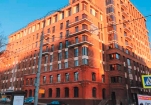Classic Green Technology: Curtain Wall Systems

Curtain Wall systems (CWS) are gaining widespread acceptance in Russia. Variety of finishing options and convenience in maintenance make them indispensable in the construction of modern buildings. But the most essential is that they effectively protect buildings from outside weather conditions, keeping warm in winter and cool in summer and providing significant energy savings. Here we talk to the Chairman of Board of Directors of the DI AT Group of Companies, Honored Builder of Russia, a laureate of the Russian Government Award in the field of science and technology, PhD in Technical & Engeneering Sciences Evgeny Tsykanovsky about advantages of CWS and how not to be mistaken at their choice.
Evgeniy Yulievich, DI AT Group has been working on the Russian market for more than 20 years, so, in fact, the formation of facade systems market has happened before your very eyes. How do you estimate its condition today?
Yes, you are right, the CWS market has been formed just before our very eyes, though, actually, in the facade business we have been about 14 years (since 1999). Before that we were engaged in other sector similar by ideology – roofing, which, in fact, is also engineering system. At a point of our entry on this market the existing players offered either imported systems or copied from the imported ones. Actually, CWS technology did not have any good luck (from the point of view of a final consumer) - at the point of mass appearance on the market of these systems, which had been caused by the first change of norms of energy saving, there were no normative-technical documents and requirements. Neither climate nor fire peculiarities of our market were taken into consideration. Imported systems frequently were worked out for low buildings of Italian seaside which are exploited only in summer, or for Germany, where in case of fire a fire brigade arrives in 5-7 minutes. We were the first on this market who started a large-scale elaboration of normative documents that in 2009 led to the Russian Government award in the sphere of science and technics for working out the theory of CWS.
Facade systems are presented on the market in quantity. How to differentiate, which will work for a long time without any troubles for the owners of the buildings, and which will be of maximum safety?
The most dangerous participants of the facade market are those, who sell not a system but iron by the weight. As a rule, you can distinguish them by a non-real low price for their production and lack of the project division. Usually they provide a Technical certification (necessary but a categorically insufficient document the absence of which just forbids the application of CWS), the album of technical solutions with 5 – 6 junctions, a calculation of facing of a hypothetical fragment of an endless concrete fence and that is it. Though our experience hints that usually at an object there are a great number of non-type junctions, so in every concrete project they must apply profound engineering solutions which provide an actual safety of maintenance for many years. All these often are farmed out to the developer which also is frequently financed on leftovers.
Indeed, there is also a fault of customers themselves. The only one who wants to be cheated may then be cheated. The person, who believes that the price of a facade construction can be infinitely reduced. The one, who sincerely supposes that the problem of disorder of fire regulations can be settled with the help of money with a regional fire inspector. The one, who does not take the building for further maintenance, but sells it to honest buyers like you and me, and does not take any responsibility about its maintenance. And if we take into consideration that besides fire norms also sanitation ones are often broken (I mean living comfort, fungus on the walls, etc.), then out of a good technology we can frequently get an opposite result, that, unfortunately, we face on the buildings which are constructed in the beginning or middle of zero ages of our century.
Full version you can download here
 Text: Vladimir Ermak
Text: Vladimir Ermak


